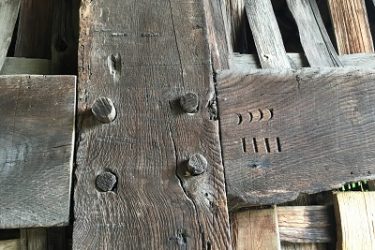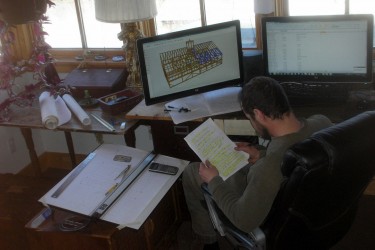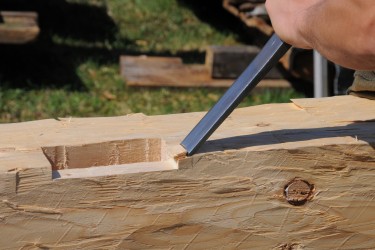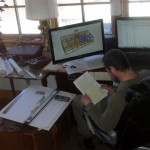Dendrochronology
The analysis of timber frames often reveals a great deal about a building’s provenance. The evolution of building techniques, tools and layout methods can offer a great deal of insight about a structure’s origins. Some details, like the marriage marks pictured here, are more obvious than others. The wood itself often contains a more definitive record a building’s age. This can often be revealed through dendrochronology.
Dendrochronology is defined by the Oxford English Dictionary as: “The science or technique of dating events, environmental change, and archaeological artifacts by using the characteristic patterns of annual growth rings in timber and tree trunks.” Using this technology, it is possible to determine the felling dates of timbers used in the construction of timber framed structures with a high degree of accuracy. Typically, early American structures were cut and erected while the wood was still green, often within a year of felling, making dendrochronology a valuable tool in the discovery of construction dates.
Our partner company, Transom Historic Preservation Consulting, provides coring services for the submission of samples to the Oxford Dendrochronology Laboratory located in Oxfordshire U.K. The Oxford Dendrochronology Laboratory works closely with the Research Laboratory for Archaeology and the History of Art at Oxford University and has dated many prominent historic structures throughout the United States. More information about Dr. Daniel Miles, dendrochronology and the laboratory can be found here. For information about rates and eligibility for sampling, please contact me directly.

Dendrochronology
Much like the first time I saw a barn raising, these carved boxes really called to me. I’m a very visual and hands-on type of person and both of these crafts are just that.
The more research I do into the history of early 18th century furniture making the more fascinated I become, particularly with green wood working and solving the mysteries of early layout systems. A compass, square and gouges are the tools used to layout the geometry plus a good eye for aesthetics and spatial patterns.
Most of the original pieces I’ve seen usually have just the front panel carved but I like to carve the side panels as well. When viewing the boxes you can see two faces and with a raking light it is truly stunning.
I use two types of wood for the boxes. I use radially riven red oak for all of the panels and sometimes for the lid. I use sawn eastern white pine as a secondary wood for the bottom board and sometimes for the lid. Oak and pine are used for the interior till compartment as well. The till lid also serves to prop open the main box lid. I enjoy making these boxes entirely with hand tools with the exception of a chain saw to cut the massive oak logs (sometimes twenty four inches in diameter) into smaller sections for riving. From there I use both metal and wooden wedges to open up the log by always riving into halves. I then use a traditional froe to rive the oak into panel planks. Flattening and sizing the boards is achieved with a broad hatchet and hand planes. When the boards have air dried to an acceptable moisture content I begin the carving.
Several years ago, I attended a class at the Yestermorrow deisgn/ build school in Warren VT, on traditional chair making techniques. After working on chairs for a few years I decided to take a class with Peter Follansbee on making traditional 18th century boxes. What began as a source of fascination on the side of my work as a joiner has now grown into an extension of my craft. Please feel free to browse the photos below showing the process of making a box. If you are interested in purchasing any of my pieces or would like something made to order please feel free to contact me at seth@knobbhill.com

Dendrochronology
Knobb Hill offers drafting services for purposes of historic documentation in addition to design services for new construction. Our scaled, three dimensional drawings are often used in conjunction with written documentation by those seeking grant assistance. These drawings also serve as blueprints for restoration projects. As with much of our joinery work, we have been accustomed to doing things the ‘old-fashioned’ way. It took a bit of convincing for us to shift our drafting work away from the drawing board and onto the computer. The advantages of the three-dimensional design are undeniable but we still have a soft spot for hand drawing and are glad to do so upon request.
We offer design services for the construction of new residential structures and outbuildings. We have often been called upon to work in collaboration with homeowners to help define goals and uses of space in addition to drafting the joinery and architectural style of the new structure. Although we specialize in pre-Civil War styles of architecture, we are not afraid to bend the rules of specific architectural styles or create entirely unique structures. Our approach to architecture is informed by old traditions of mathematical proportioning. We often draw directly from the five classical orders of architecture as well as the neo-classical interpretations of the orders as found in New England’s historic vernacular architecture. Over the past few years, we have been exploring the almost forgotten art of daisy wheel design and found that many of the earliest structures in Vermont use this simple method to define their proportions. We often use the daisy wheel to define the footprint and basic proportion of new structures and then apply either proportions of the classical orders or to a lesser extent, attributes of the romantic styles of architecture to define fenestration and other embellishments.
Many of the drafts in the gallery below correspond to frames found on the projects page of this site.

Dendrochronology
The challenges of timber framing have brought me great satisfaction over the years and a few frustrations too. I have gained a wealth of knowledge from working with old buildings and studying the craftsmanship of early builders. I’m thankful for all of the framers who have shared their knowledge with me and in turn, I feel a strong responsibility to share my knowledge and help to influence others to work with their hands. In addition to restoring and preserving old frames, teaching is a way that I can give back to the craft that means so much to me.
I have been teaching timber framing since early 2000. I have taught full semester courses in addition to three-week intensives at The Institute of Social Ecology. I have been a regular instructor at the Yestermorrow design/Build School in Warren Vermont with my good friend Skip Dewhirst for many years now. I have also served as an instructor for an intensive at Dartmouth College, lectured for the Historic Preservation program at UVM and instructed local high school students through a grant from The History Channel. Aside from teaching through conventional venues, Michael and I have worked with individuals to teach the craft and assist with the logistics of seeing their own projects to completion.
-Seth Kelley

Dendrochronology
Ever since we participated in our first Vermont History Exposition in 2004, we have been hooked on doing live demonstrations, talks and workshops. We have done hands on demonstrations at the Solar Fest in Tinmouth, the Garlic festival in Montpelier and the International Preservation Trades Workshop in Barre. The opportunity for us to participate in these events not only gives us a chance to share some of our skills and knowledge with others, but also meet and learn from other history buffs. We have made great connections with many older Vermonters who have shared their memories and anecdotes with us. Hopefully, our participation in these events has inspired some of the younger generation to take up an interest in local history as well. In addition to the larger venues of expositions and festivals we have also been participating on a smaller, more intimate scale with local historical societies offering lectures and slide shows. Let us know if there is an event that you think might be relevant to us and keep your eyes peeled for us on the front lawn of the Pavilion Building in Montpelier on July 16th 2011 at the Washington County History Fair.




